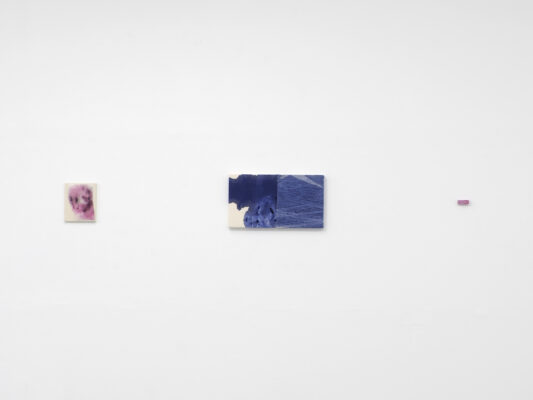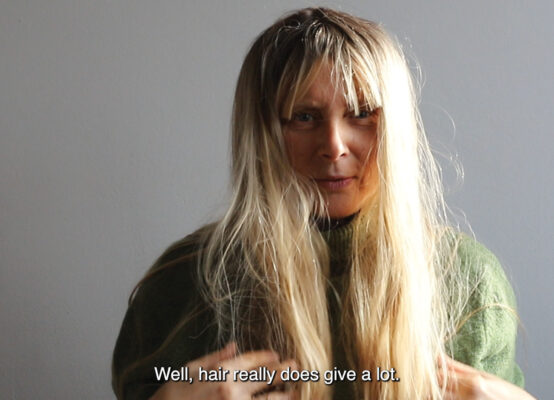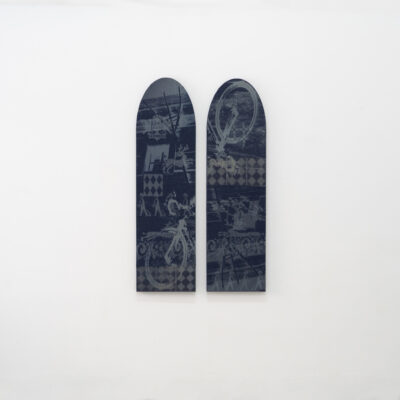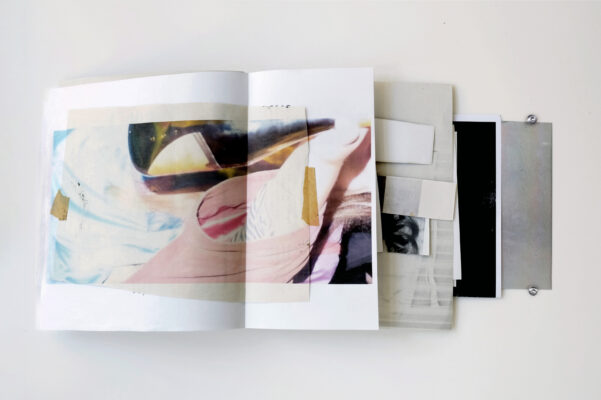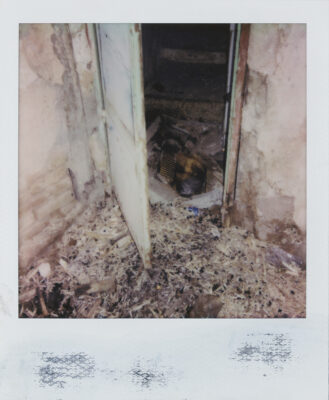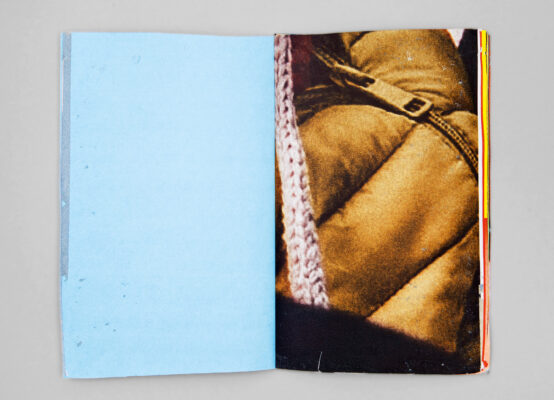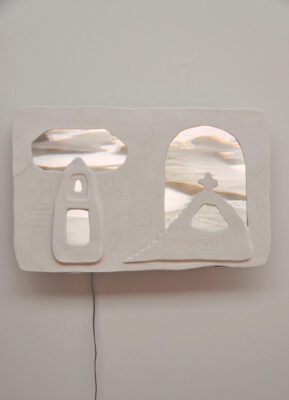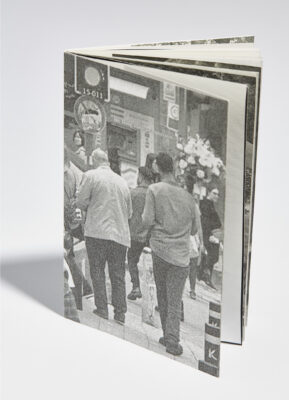Opening: Monday, 17 March 2025, 7 pm
Opening speech: Johan Nane Simonsen
With PROPELLER I (lat.: propellere “to propel forward”), a biennial exhibition format began in 2019, each of which aims to reflect on current events at Austrian art academies. How do young artists work today in the fields of photography and new media? On the one hand, FOTOGALERIE WIEN wants to make student work visible to a broader audience, and on the other hand, it wants to give students the opportunity to get to know the exhibition business better. The current student works presented in this exhibition, PROPELLER IV, show an extremely wide variety of materials and forms of presentation. Photography and video are placed in installative, sculptural, painterly and publicist contexts, thus expanding their form and content. Thematically, there is a clear shift towards an examination of identity, the search for refuge, security and the longing for poetry.
As part of her exploration of questions of (gender) identity, belonging and family, Walentina Kaja Ammann deals with the highly sensitive topic of “hair” in her artistic documentary Nest. In the 30-minute video, female members of her family wear a wig made from the artist’s hair. In interviews, they talk and reflect on the significance of hair in their lives. The video raises questions about the influence of hair on femininity and explores the boundary between family and personal identity. Short cuts between the interviews show the transformation of the artist’s hair, returning again and again to the initial question of role models.
Christoph Bisenberger presents two artist’s books made from found material from public billboards. These large billboards on the outskirts of cities, on entry and exit roads and on country roads are repeatedly pasted over with new motifs. Over time, the original advertisement is buried under a thick layer of paper. Bisenberger is interested in dissecting these layers of paper. He cuts a fragment out of a poster board – from the top layer down to the base plate. Using water, he exposes the individual layers. In book form, they are a play of abstract shapes and colors, an invitation to slowness and poetry.
In the Hüttenwanderung series, Adrian Czubatinski visualises the theme of “home/homeland” through performative actions captured in photographs that deal with the architecture and symbolism of shelters. In the great outdoors they provide a place of refuge and security. Even though they are usually just wooden huts, they are often perceived as places of romantic fantasies of freedom and closeness to nature. The human longing for security that emanates from a home is reflected in the abstract depiction of a house. Czubatinski now goes one step further and sends the shelter itself on a journey. He stages it in public space as a symbol of uprootedness. It is both comforting and unsettling to know that “home” can be anywhere, but that you may never really settle down (from a text by Liam Floyd).
I never touched a pigeon by Jana Ehls is a multimedial work that deals with the question of absence and blind spots in expanded photography. The title refers to Johann von der Keuken’s film “Blind Kind” (1964) and results from the discovery that sighted people are „blind” to perceive the world in an exclusively tactile way. A blind child recognizes a pigeon by touch, a seeing child by sight. In recognition of this discrepancy in knowledge, Ehls explores the limits of perception and the possibility of relearning to see. The projected videos refer to this process: By zooming in, the view becomes limited, the movement of the object faster and unpredictable. The video projection is accompanied by an artist’s book containing traces of absence, blind spots and parts of the series index of things that are not mine.
like being stuck as a spectator by Adriana Finghis explores the imaginary space beyond the photographic subject that arises from the fragmentary nature of photography. Since images can only ever be excerpts, the surrounding void becomes a place that invites the projection of meaning. The photographic positions, developed through a combination of analog and digital techniques, are complemented by an artist’s book. In this book, text fragments from conversations, stories, and dream interpretations sourced from anonymous online forums are interwoven and recombined. The result is a series of diffuse dialogues that serve as vague markers, defining key points within a site. At its core, the work reflects on a shared sense of humanity and examines the question of what images reveal and what they conceal.
Johannes Hartmann works in the field of tension between fashion design and transmedia art. Knitted Sensitivities is a series of knitted paintings that explore the properties of knitted fabric. In contrast to the traditional, strictly regulated craft of knitting, Hartmann’s approach is intuitive and spontaneous. The knitting of a rectangular piece is followed by a painterly reaction on its surface. Slight irregularities in the texture are accentuated with textile printing paste. The yarn is then unravelled, rewound onto a cone and knitted again. Despite using identical machine settings, the painted areas dissolve into abstract shapes, due to subtle shifts in the positioning of the yarn’s painted spots of yarn and the tension of the machine. This is again followed by a painterly reaction, whereby this process is repeated several times in some works.
In her work Do not split, which pushes photography to its limits, Mara Printz presents objects made from photographic materials and devices that deliberately refuse to conform to a clear narrative. They play with the mysterious, the hidden that needs to be deciphered. “I imagine a place of investigation. Evidence is lined up, packaged, preserved. Observation of observations. Maybe it’s about clues, maybe it’s about a crime. Maybe it’s about ghosts, maybe it’s even about hunting ghosts. Maybe it’s just about whispers.” (Mara Printz)
In the photographic installation project Ghorbats, Farhang Rafiee tells the story of a historical district in Sabzevar in Iran, his hometown. Its residents, historically known as “Ghorbats”, are said to have cultural and historical ties to the Roma and Sinti – people who migrated from India centuries ago and settled in this city, among others. This community has endured centuries of systematic racial discrimination and social marginalization. Their neighborhood, known for its distinct cultural heritage and historical identity, is on the verge of destruction due to a lack of government support. The project is based on oral narratives from community members and photographs documenting their lived experiences. These not only reflect a specific local experience of racism, but also universal patterns of discrimination and resilience.
In the Âncora project, Ana Sofia Rocha de Matos combines a static three-dimensional with a moving image: an openwork stoneware in front of a monitor showing a video. The sculpture is a “flattened expression” of the fictionalised Portuguese coastal town of Vila Praia de Âncora, which is familiar to the artist. “In search of the archaeology of rural modernity, and of the self”, she has visited this place “since birth” and draws her artistic inspiration from it. The sculpture refers to three spaces that form the basic of the project: The Calvary, The Infirmary and The Desert/Flood. Windows provide glimpses into this universe; each has a meaning and symbols are assigned to each space. The video, “perhaps an attempt at geographical possession”, is intended as an archive of her early visits in 2023.
Gabriel Rózsa’s installation Der Schein trügt combines an examination of the “house” as a place of refuge with the authenticity of photography. A candle stands in front of a small house made of plywood. The warm, illuminated house symbolizes a safe, cozy retreat. But the house object also functions as a pinhole camera: the light from the candle is projected through a small hole into the interior of the house and reproduced on its back wall, upside down and inverted. The flame illuminates the room, but at the same time reveals the deceptive nature of fire. The photograph’s claim to truth and the photographed subject appear as a burnt hole in the place of the image of the flame.
Lorenz Wanker’s diptych JOSEF, made of laser-fired denim on wood, explores the tension between innovation and tradition. Raised in Vienna and Carinthia on his grandparents’ farm, the artist juxtaposes his rural origins with urban modernity. He brings these two worlds together by using cross-stitch, a traditional embroidery pattern with rural and religious motifs, transferred to denim using a digital production technique – laser engraving. Blue jeans have a long history; they are as much an old and traditional material as they are a consumer product and leisure wear for the the wider population. They became a symbol of rebellion against tradition, authority and the oppression of women – everything that cross-stitch once stood for.
Petra Noll-Hammerstiel






